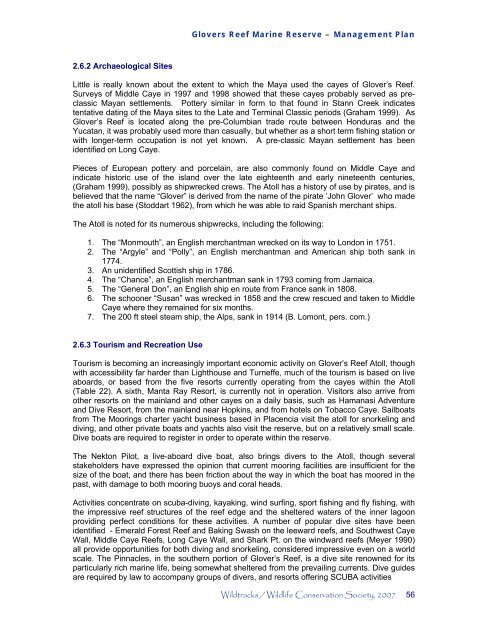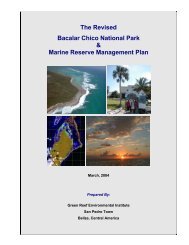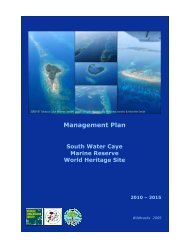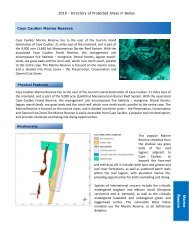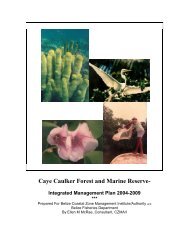Management Plan - Glover's Reef Marine Reserve
Management Plan - Glover's Reef Marine Reserve
Management Plan - Glover's Reef Marine Reserve
You also want an ePaper? Increase the reach of your titles
YUMPU automatically turns print PDFs into web optimized ePapers that Google loves.
2.6.2 Archaeological Sites<br />
Glovers <strong>Reef</strong> <strong>Marine</strong> <strong>Reserve</strong> – <strong>Management</strong> <strong>Plan</strong><br />
Little is really known about the extent to which the Maya used the cayes of Glover’s <strong>Reef</strong>.<br />
Surveys of Middle Caye in 1997 and 1998 showed that these cayes probably served as preclassic<br />
Mayan settlements. Pottery similar in form to that found in Stann Creek indicates<br />
tentative dating of the Maya sites to the Late and Terminal Classic periods (Graham 1999). As<br />
Glover’s <strong>Reef</strong> is located along the pre-Columbian trade route between Honduras and the<br />
Yucatan, it was probably used more than casually, but whether as a short term fishing station or<br />
with longer-term occupation is not yet known. A pre-classic Mayan settlement has been<br />
identified on Long Caye.<br />
Pieces of European pottery and porcelain, are also commonly found on Middle Caye and<br />
indicate historic use of the island over the late eighteenth and early nineteenth centuries,<br />
(Graham 1999), possibly as shipwrecked crews. The Atoll has a history of use by pirates, and is<br />
believed that the name “Glover” is derived from the name of the pirate ’John Glover’ who made<br />
the atoll his base (Stoddart 1962), from which he was able to raid Spanish merchant ships.<br />
The Atoll is noted for its numerous shipwrecks, including the following:<br />
1. The “Monmouth”, an English merchantman wrecked on its way to London in 1751.<br />
2. The “Argyle” and “Polly”, an English merchantman and American ship both sank in<br />
1774.<br />
3. An unidentified Scottish ship in 1786.<br />
4. The “Chance”, an English merchantman sank in 1793 coming from Jamaica.<br />
5. The “General Don”, an English ship en route from France sank in 1808.<br />
6. The schooner “Susan” was wrecked in 1858 and the crew rescued and taken to Middle<br />
Caye where they remained for six months.<br />
7. The 200 ft steel steam ship, the Alps, sank in 1914 (B. Lomont, pers. com.)<br />
2.6.3 Tourism and Recreation Use<br />
Tourism is becoming an increasingly important economic activity on Glover’s <strong>Reef</strong> Atoll, though<br />
with accessibility far harder than Lighthouse and Turneffe, much of the tourism is based on live<br />
aboards, or based from the five resorts currently operating from the cayes within the Atoll<br />
(Table 22). A sixth, Manta Ray Resort, is currently not in operation. Visitors also arrive from<br />
other resorts on the mainland and other cayes on a daily basis, such as Hamanasi Adventure<br />
and Dive Resort, from the mainland near Hopkins, and from hotels on Tobacco Caye. Sailboats<br />
from The Moorings charter yacht business based in Placencia visit the atoll for snorkeling and<br />
diving, and other private boats and yachts also visit the reserve, but on a relatively small scale.<br />
Dive boats are required to register in order to operate within the reserve.<br />
The Nekton Pilot, a live-aboard dive boat, also brings divers to the Atoll, though several<br />
stakeholders have expressed the opinion that current mooring facilities are insufficient for the<br />
size of the boat, and there has been friction about the way in which the boat has moored in the<br />
past, with damage to both mooring buoys and coral heads.<br />
Activities concentrate on scuba-diving, kayaking, wind surfing, sport fishing and fly fishing, with<br />
the impressive reef structures of the reef edge and the sheltered waters of the inner lagoon<br />
providing perfect conditions for these activities. A number of popular dive sites have been<br />
identified - Emerald Forest <strong>Reef</strong> and Baking Swash on the leeward reefs, and Southwest Caye<br />
Wall, Middle Caye <strong>Reef</strong>s, Long Caye Wall, and Shark Pt. on the windward reefs (Meyer 1990)<br />
all provide opportunities for both diving and snorkeling, considered impressive even on a world<br />
scale. The Pinnacles, in the southern portion of Glover’s <strong>Reef</strong>, is a dive site renowned for its<br />
particularly rich marine life, being somewhat sheltered from the prevailing currents. Dive guides<br />
are required by law to accompany groups of divers, and resorts offering SCUBA activities<br />
Wildtracks / Wildlife Conservation Society, 2007 56


